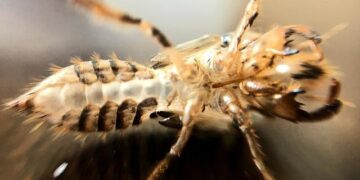ByRachel Fobar
Published December 11, 2023
• 15 min read
NAPLES, FLORIDA“It’s a good night for a python hunt.”
The air is thick and soupy. Pythons seem to like stormy, humid air, says professional hunter Amy Siewe, and Hurricane Idalia is about to make landfall in Florida.
In about nine hours over two nights, Siewe catches, and kills, four Burmese python hatchlings. She spots them from atop a so-called snake deck—a platform drilled into the bed of her white Ford truck affixed with floodlights. We cruise down highways 29 and 41 in Naples, driving no faster than 25 miles per hour as she looks for snakes in the grass.
A blonde with a bright smile, Siewe, 46, left behind a thriving real estate business in Indiana in 2019. On a vacation to Florida earlier that year, she’d gone on a python hunt and was hooked. “This is what I’m supposed to be doing,” she says. She used to work for the state python-hunting program, but it didn’t pay enough to live on. Now, she leads small groups of two to four people on guided hunts for $1,800 a night, teaching civilians how to kill the invasive reptile, which has taken hold throughout much of Florida.
Siewe preps me on what to look for: the snakes are mostly motionless, and their eyes don’t shine in the light, but their skin has a plastic sheen. Our best bet is to come across one that’s periscoping, or holding its head high. Siewe shows me a photo on her phone of a python she’d found recently. On the screen, the snake is circled in yellow, but I still have trouble spotting it.
“Python!” she shouts. Dave Roberts, her partner both in life and snake-catching, slams on the brakes and she jumps out. Twisting and squirming, the hatchling struggles in her grasp, its jaws wide open. She holds the snake just behind its head so it can’t bite her.
About two feet in length, these hatchlings are nothing compared to the 19-footer she helped catch last year, but she counts this as a victory. It takes a python about 200 prey animals and three years to reach 10 feet in length, Siewe estimates. “Every [python] that we’re taking out is making a difference.” (Read about the largest-ever python found in Florida.)
I film the catch with my iPhone camera, but when it’s time to kill the python, Siewe has me turn it off—this part’s not for show. “It’s really unfortunate what we have to do to these pythons,” she says. She’s loved snakes her whole life and has “great respect” for them, she says.
“Unfortunately, there’s no option.” Normally she and Roberts use a bolt gun to kill the pythons they catch, but because this one’s so small, Dave uses a pellet gun while she holds the snake steady. The wriggling tail instantly goes still.
It’s no secret that Florida has a python problem. Since at least 1979, Burmese pythons have slithered over the southern tip of Florida, including Everglades National Park, gradually expanding their range to nearly a third of the state. The species, native to southeastern Asia, arrived in Florida likely sometime mid-century via the exotic pet trade. It’s now illegal to acquire one as a pet in Florida.
Though Florida is a hot spot for invasive species, pythons are particularly tricky—a January study by the U.S. Geological Survey called them “one of the most intractable invasive-species management issues across the globe.” These snakes thrive in Florida for several reasons—their coloring makes them difficult to spot, they’re often most active at night, and they spend much of their time submerged underwater or hidden in vegetation. The fact that the Everglades are watery and largely uninhabited, as well as cover thousands of miles, only compounds the issue. “They don’t really lend themselves to being trapped well,” says Melissa Miller, a University of Florida ecologist working on a python-tracking program.
Over the last few decades, these gigantic reptiles have wrought havoc on the state’s ecosystems. The constrictors have decimated native wildlife, including opossums, rabbits, rats, and foxes, with some suffering a decline of up to 99 percent, according to roadside surveys. They’ve swallowed pets, from legions of neighborhood cats to a 60-pound Siberian husky. Scientists keep a running list of the threatened or endangered animals that have been found in python stomachs: state-listed species like the little blue heron, roseate spoonbill, and Big Cypress fox squirrel; federally threatened species like the wood stork; and federally endangered species like the Key Largo woodrat and Key Largo cotton mouse. They compete with other predators, including bobcats, Florida panthers, and native snakes, for prey.
And as adults, they have few known predators—basically American alligators and crocodiles, bobcats, other snakes, and potentially Florida panthers, according to the USGS study. (Read more about Florida’s panther conservation efforts.)
“It’s an emergency situation we’re in,” says Mike Kirkland, senior invasive animal biologist and python elimination program manager for the South Florida Water Management District.
Bankers turned bounty hunters
It’s unknown how many Burmese pythons live in Florida: some estimate tens of thousands, others such as Florida Fish and Wildlife say it could be as many as 300,000. Siewe suspects those estimates are conservative. Even many experts agree that with the methods currently available to them, the goal of eliminating invasive pythons, which can live more than 30 years, is unattainable.
Every week, Kirkland, 48, gets emails, letters, phone calls, and even in-person office visits from members of the public who tell him why his life’s work is fruitless. “A lot of people have expressed that we’re never going to get a hold of this,” he says.
He also hears their theories on how they should be tackling the problem—everything from carpet-bombing the Everglades with porcupines to introducing African elephants to trample them to flooding the entire southern region of Florida. “I try to be responsive to everyone,” Kirkland says. “Some of them are pretty out there.”
But so far, certain data shows that killing the pythons one by one is the best option compared with trapping, using dogs, luring snakes using pheromones, and other methods.
In 2017, the state began paying designated python hunters up to $18 an hour to seek out and kill the reptiles. On average, Kirkland says he receives a hundred applications a week, but only a handful make it to the interview stage—mainly those that already have some snake-catching experience. Hunters have since removed more than 13,000 snakes from the state, and Kirkland’s hunters are responsible for more than half, he says. They’re also authorized to euthanize other invasive snakes, including the Northern African python, the reticulated python, and boa constrictors.
He leads a “colorful” team of 50 hunters, and Florida’s Fish and Wildlife Conservation Commission has another 50. Kirkland’s team doesn’t hunt full-time—during the day, they’re bankers, lawyers, club bouncers, alligator wrestlers, “you name it,” he says. It’s a diverse team, but they all have a few things in common, he says: they love snakes, and they’re good at catching them.
Even though it’s “daunting,” Miller says it’s important to “have hope” if you’re doing research or managing invasive species. “If you just do nothing, then what? Then we don’t have native wildlife,” she says.
Vetting for bloodlust
Just outside of Miami, there’s a road along a levee on which only government contractors can drive to hunt for pythons.
On an early September evening, Kirkland accidentally drives right past it.
“I don’t get nervous when National Geographic gets here, not at all,” he jokes as he misses his exit. He turns the truck around and pulls onto the levee road.
Kirkland has good reason to be wary—in the nearly seven years he’s led the python-hunting program, Florida has gotten plenty of condemnation from animal welfare groups and journalists alike.
Clifford Warwick, an independent biologist and reptile expert in London, calls the python hunts “a waste of time.” Python populations will continue growing for now, but eventually, they will stabilize, he says. “I’m not somebody who is anti-control,” he says. “But you really have to weigh up the overall amount of damage involved and balance that against the humaneness.”
Particularly contentious is the state’s annual python challenge, which Florida’s Fish and Wildlife Conservation Commission launched in 2013. Today, the contest, which is jointly hosted by the FWC and the SFWMD, offers more than $30,000 in prizes and draws well over a thousand participants—some of whom have never hunted a python before—“plus enough newsfolk to staff a half-dozen O.J. Simpson trials,” writes one journalist. (Private citizens, such as Siewe, can also hunt snakes.) The event is “designed to help get the public engaged,” Kirkland says—and it does. This year’s hunt attracted 1,050 participants who killed 209 snakes during the 10-day challenge.
People for the Ethical Treatment of Animals (PETA) has called the contest a “grotesque” event that “sets laypeople loose to botch python killings.” At the first challenge in 2013, National Geographic described the apparent inexperience of some of the participants, including ones “who had never seen a Burmese python before” and one who recommended “swing[ing] a snake by the tail and slam[ming] its head into a tree” to stun them.
The Florida FWC uses the American Veterinary Medical Association’s humane euthanasia standards for reptiles: knock them out and destroy the brain. Decapitation is also an approved euthanasia method, so long as the snake is unconscious and it is followed by immediate pithing, or scrambling the brain with a needle or metal rod.
Warwick calls decapitation a “brutally cruel” method, and he thinks it’s unlikely that civilian hunters routinely pith the snakes’ brains. “The head stays alive for maybe half an hour to an hour, and it’s fully conscious, and it will feel all the pain of the severance,” he says.
Though pythons are protected by state anti-cruelty laws, it’s difficult to catch perpetrators.
“We do encourage the humane removal of pythons,” Kirkland says. “Is it a concern? Sure.” He says the state has conducted outreach to educate the public on how to humanely kill pythons. Plus, contracted hunters and python challenge participants are required to minimize the animal’s suffering.
“I won’t work with anyone that has a bloodlust for these things,” he says. When Kirkland vets applications, he avoids people who want to kill pythons “because they hate them.” He says this is “a native-animal-saving program, not a snake-killing program.”
“The day I become desensitized to it is the day I quit,” Kirkland says. “It’s very, very upsetting, but I’m really glad I’m in charge of this, because we make sure that the animals are treated with respect.”
Sleepless nights
“Every other night.”
That’s Kirkland’s answer when I ask him how much he sleeps, on average. Instead, he stays up, watching moving dots on a map. These are the live locations of his python hunters, traceable via their mobile phones. He watches them every night they’re out, until the hunters eventually go home and the dots disappear, sometimes as late as 4 a.m.
Kirkland has been married for 25 years to a very understanding wife, he says—but he doesn’t have kids. “I’ve got 50 kids already,” he says, referring to his hunters.
Although python hunters grab the public’s attention, about 75 percent of Kirkland’s $1.1 million annual budget goes into researching new elimination methods.
For instance, researchers with the U.S. Fish & Wildlife Service and Southern Illinois University have outfitted opossums and raccoons with tracking collars affixed with sensors that are triggered when the animal dies. Experts can then find the offending python and remove it.
Another team with the University of Florida has tried setting out live rabbit pens to lure the pythons out of hiding, so they can be killed. (The rabbits are fed, watered, given toys, and then put up for adoption afterward.)
Kirkland has also co-funded projects that track python movement and behavior, including one by University of Florida’s Miller, who found one snake on a nest of 111 eggs, and she had 25 more inside her. Females typically lay between 40 and a hundred eggs every two years. (See the first-ever photos of bobcats raiding a python nest.)
Kirkland’s even working with geneticists. One of their more ambitious ideas is to edit Florida pythons’ genes so only males can be born. But not only is it expensive, it would take decades to see results, and he’d have to convince the taxpaying public that it’s a good idea to raise, house, and release thousands of gene-edited snakes into the wild. “But just because it’s challenging or difficult to do doesn’t mean that we shouldn’t do it, right?”
Prolonging extinction?
Is all this effort in vain? Even the pros can’t help but ask that question.
“Sometimes I wonder, you know, are we just prolonging the extinction of some of these [native] animals?” Siewe asks. “I hope not.”
For now, Kirkland says “human detection and removal is the most effective means we have to manage the python issue,” but he’s more excited about what’s to come.
“I really want to see the Everglades in a much better place than it is now by the time I retire,” he says. “I’m optimistic that we’re going to reduce the python population enough so that native animals can return.”
The National Geographic Society supports Wildlife Watch, our investigative reporting project focused on wildlife crime and exploitation. Read more Wildlife Watch stories here, and send tips, feedback, and story ideas to [email protected]. Learn about the National Geographic Society’s nonprofit mission at natgeo.com/impact.
>>> Read full article>>>
Copyright for syndicated content belongs to the linked Source : National Geographic – https://www.nationalgeographic.com/animals/article/invasive-python-hunts-in-florida































